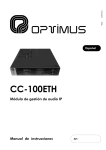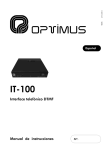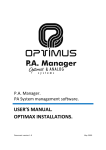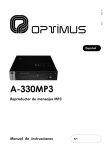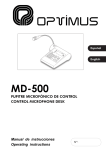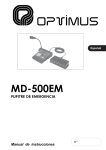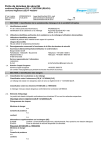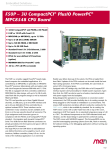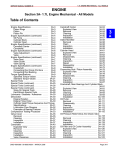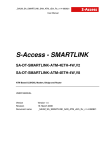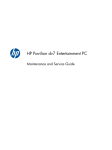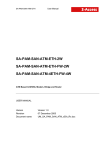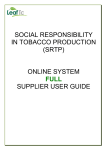Download UMX-ETH - Optimus
Transcript
9I264 28/12/10 UMX-ETH IP NETWORK CONNECTION CARD FOR UMX-02/0 MODULAR MATRIX CONTENTS 1. CHARACTERISTICS .............................................................................................................. 5 2. ELEMENTS ............................................................................................................................ 5 3. INTERNAL CONFIGURATION ................................................................................................ 6 4. STARTING UP A UMX-ETH CARD .......................................................................................... 7 4.1. Configuration of the IP address ....................................................................................... 7 4.2. Positioning the card in the UMX-02/0 chassis and connections............................................. 9 4.3. Adding the card to the installation by means of the P.A. Manager software ........................... 9 4.4. Configuration of the parameters of the UMX-ETH card ...................................................... 10 4.4.1. Configuration of the General tab .......................................................................... 10 4.4.2. Configuration of the Others tab .......................................................................... 13 4.5. Connecting the equipment in the installation structure ..................................................... 13 4.6. Sending configurations to the unit ................................................................................. 14 4.6.1. Sending configurations to a UMX-ETH card .......................................................... 14 4.6.2. Sending configurations to a UMX-02/0 through a UMX-ETH card ............................. 14 5. CONFIGURATION OF THE UNIT IP ADDRESS BY SOFTWARE .............................................. 15 6. INSTALLATION EXAMPLES ................................................................................................. 17 6.1. Installation 1 .............................................................................................................. 17 6.2. Installation 2 .............................................................................................................. 19 7. NETWORK SPECIFICATIONS .............................................................................................. 21 8. TECHNICAL SPECIFICATIONS ............................................................................................ 23 9. SOFTWARE AND FIRMWARE VERSIONS ............................................................................. 23 10. DOCUMENT VERSION TRACKING ....................................................................................... 23 11. GUARANTEE ....................................................................................................................... 24 UMX-ETH version 2.1 R&D Department 4 UMX-ETH IP NETWORK CONNECTION CARD FOR UMX-02/0 MODULAR MATRIX 1. CHARACTERISTICS This card supports the connection to an IP network of the UMX-02/0 microprocessed audio matrix, sending or receiving AUDIO via streaming, in addition to control data and equipment configuration. Any signal that comes from a UMX-02/0 input card (UMX-2E, UMX-EGC, UMX-ECT, UMX-TEL or UMX-MP3) can be sent via Ethernet using the UMX-ETH card. In the same way, the audio signals or data received via IP by a UMX-ETH card are communicated to the output cards of the UMX-02/0 (UMX-2S, UMX-SCT). Principal characteristics: Digital audio by means of an IP connection. Double Ethernet connection for installations with redundant network systems. DSP functions for the IP channels: volume, bass and treble. Each card occupies a position on the bus of a UMX-02/0. Through internal configuration, they are divided into music program and/or paging cards. The maximum number of UMX-ETH cards in a UMX-02/0 is one paging card, one program card and one control card. Operation in stand-alone mode or with P.A. Manager control software. Surveillance of equipment operation by means of P.A. Manager software and/or basic TELNET functions. IP address configuration by means of DIP switches, facilitating the replacement of equipment in an installation, or remotely through software. 2. ELEMENTS (1) CTRL OUT strip. Not used. (2) ETHERNET A connector RJ45 type connector. Used for connection to the ETHERNET network. Cat 5 STP cable must be used for its connection. (3) ETHERNET B connector RJ45 type connector. Used, in a redundant network, as a secondary connection to the ETHERNET network. Cat 5 STP cable must be used for its connection. If the connection to ETH A fails, the card automatically uses this connection, so that the PA system continues to operate. (4) ETHERNET A input 10 Mb LED indicator Figure 1 network speed of 100 Mb (use of a transmission speed of 100 Mbps is highly recommended). (5) ETHERNET A input ACT LED indicator ACTIVITY indicator. It lights when data is being sent or received through the ETHERNET A input. (6) ETHERNET A input LINK LED indicator When lit, it indicates connection of the ETHERNET A input to the IP network. (7) ETHERNET B input 10 Mb, ACT and LINK LED indicators These serve the same purpose as the ETHERNET A indicators, applied in this case to the ETHERNET B input. Indicates the speed of the IP network connected to the ETHERNET A input. If the LED is lit, it indicates a speed of 10 Mb. If unlit, it indicates a UMX-ETH version 2.1 R&D Department 5 UMX-ETH IP NETWORK CONNECTION CARD FOR UMX-02/0 MODULAR MATRIX 3. INTERNAL CONFIGURATION In most cases the card is already factory configured, according to the specifications of the client, to function as a music program, paging or control card. If you wish to change this configuration, you must modify resistors R69, R70, R71 and R74 as specified in the following tables: (-- = Remove resistor) Operation as a PAGING Ethernet card PAGING R69 R70 R71 R74 0 Ohm -- -- 0 Ohm Operation as a MUSIC PROGRAM Ethernet card PROGRAM R69 R70 R71 R74 -- 0 Ohm 0 Ohm -- R69 R70 R71 R74 -- -- -- -- Operation as a Control Ethernet card CONTROL In installations with software versions later than 2.6, it is recommended to replace the UMX-ETH control card with a UMX-CC card. Figure 2 UMX-ETH version 2.1 R&D Department 6 UMX-ETH IP NETWORK CONNECTION CARD FOR UMX-02/0 MODULAR MATRIX 4. STARTING UP A UMX-ETH CARD To start up a UMX-ETH, proceed as follows: 1. Configure the IP address of the card. Refer to section 4.1. 2. Position the card in the UMX-02/0 chassis and make the connections. Refer to section 4.2. 3. Add the card to the installation by means of the P.A. Manager software. Refer to section 4.3. 4. Configure the parameters of the card. Refer to section 4.4. 5. Connect the UMX-02/0 unit to the installation structure. Refer to section 4.5. 6. Send configurations to the unit. Refer to section 4.6. 4.1. Configuration of the IP address Before positioning the card in a UMX-02/0 chassis, its IP address must be configured. For this purpose, it has 4 internal DIP switches (see Figure 3). The IP address of the card is configured by means of these 4 DIP switches. This address identifies the card in the network, and so each equipment unit must have a unique IP address. NB: The IP address can also be set by software. To do this, refer to section 5. If this action is taken, the configuration DIP switches stop to be operative. An IP address is represented by means of a 32-bit binary number. The IP addresses are expressed as decimal notation numbers: the 32 bits of the address are divided into four octets (an octet is a group of 8 bits). On the card each octet is configured through a DIP switch (four octets four DIP switches). In an octet, each bit can have the value 0 (DIP switch OFF) or 1 (DIP switch ON). In order to obtain the decimal value of the octet, the decimal values of each bit that is in the ON position must be added up (from the top down: 1, 2, 4, 8, 16, 32, 64 and 128). Figure 3 Figure 3 shows an example in which the IP address 192.168.100.128 is configured. Table I on the next page shows all the DIP switch combinations from 0 to 255. UMX-ETH version 2.1 R&D Department 7 UMX-ETH IP NETWORK CONNECTION CARD FOR UMX-02/0 MODULAR MATRIX Table I. Configuration of the IP address. UMX-ETH version 2.1 R&D Department 8 UMX-ETH IP NETWORK CONNECTION CARD FOR UMX-02/0 MODULAR MATRIX 4.2. Positioning the card in the UMX-02/0 chassis and connections 1. Move the front switch on the UMX-02/0 to the OFF position or disconnect the power strip. Figure 4 2. Unscrew the two attachment screws and remove the blank panel from the position where the card has to be installed. 3. Insert the card. 4. Fasten the attachment screws. 5. Connect the UMX-ETH card to the IP network of the installation by means of RJ45 connector A or B. 6. Connect the power supply to the UMX-02/0 chassis and move the front switch to ON. 4.3. Adding the card to the installation by means of the P.A. Manager software To configure the card, it is necessary to have a PC connected to the network that has the SCF-01 or SCM-01 (P.A. Manager) software. 1. If the software is the SCM-01, start the application, open the Options menu and select Installations (administrator user level is required). If the software is the SCF-01, start the application. NB: Prior to configuration of the parameters of the UMX-ETH card, it is necessary to have configured the Installation and PA Area parameters. The UMX-ETH card must be added to a UMX-02/0 chassis, which in turn can depend on a P.A. Area or a DVA-102ETH. 2. Select the UMX-02/0 chassis to which you wish to add the UMX-ETH card. 3. Open the Add Equipment menu, select UMX02 and click on UMX-ETH. 4. The unit configuration screen appears. Refer to section 4.4. Configuration of the parameters of the UMX-ETH card. UMX-ETH version 2.1 R&D Department 9 UMX-ETH IP NETWORK CONNECTION CARD FOR UMX-02/0 MODULAR MATRIX 4.4. Configuration of the parameters of the UMX-ETH card 4.4.1. Configuration of the General tab (1) Slot Position occupied UMX-02/0 chassis. by the card in the (1) (2) Name Enter a name to identify the equipment unit. Maximum of 50 characters. (2) (4) (3) (3) Type (Program/Priority/Data) Select the functionality of the card: receiving/sending a (music) program signal, receiving/sending a priority signal (announcements and messages), or managing the priorities between channels in the Optimax system (Control). (5) (8) (6) (9) (7) (10) (11) (12) (13) The functionality selected must coincide with the configuration of the card’s hardware (see section 3). (4) Source Configure this option if the UMX-ETH card is used to convert the analog audio received by another card in the same chassis to digital audio. In this case, you must select the same sound source as that configured on the analog audio input card. If you send PC pre-recorded messages, you must select the same Sound Source as that configured on the PC Server and in the UMX-2E input. Therefore, the sound source and the UMX2E analog audio input card must have been configured beforehand. If the card is used to receive or send program, first you must create a proprietary Program type sound source for this functionality (menu Options Modes and Sound Sources) and select this Sound Source on the drop-down menu. IP DATA (5) IP address IP address of the UMX-ETH card. This must coincide with the configuration of the DIP switches of the card or with the address configured through the Web connection. It must be a fixed IP address. (6) Netmask and (7) Gateway In installations that require this. Consult the network administrator of the installation. UMX-ETH version 2.1 MULTICAST DATA (also see page 11) (8) IP Multicast Default setting 239.5.5.5. Do not modify this field unless the installation topology makes it necessary. All the units with an IP connection in the installation must have the same IP multicast address. (9) Multicast port Default setting 5000. Do not modify this field unless the installation topology makes it necessary. All units with an IP connection in the installation must have the same multicast port. (10) Send “Heart Beat” every (n) seconds Frequency with which the unit sends a heart beat signal to the multicast group. This signal informs the other equipment units in the installation that the system is operating perfectly. (11) Local Manager and (12) Global Manager Defines whether the UMX-ETH card is to function as a priority manager of the Optimax system, either locally at PA Area level or globally for the installation, and establishes the priority of this management with respect to other equipment units (1 = maximum priority). See Notes on Local and Global Co-ordinators on page 11. R&D Department 10 UMX-ETH (13) Gateway RS485 By activating this option, it is possible to: View the occupancy of the analog zones (UMX-2S cards) from P.A. Manager and the Optimax desks. Notify ETH alarms on the display of the UMX-02/0. View the alarms of the UMX-02/0 and the equipment connected to its RS485 bus on P.A. Manager and the Optimax desks. The UMX-ETH in this chassis is used as a gateway in mixed installations (OPTIMAX equipment units and analog units with RS485 communication), sending the data received by IP NETWORK CONNECTION CARD FOR UMX-02/0 MODULAR MATRIX the UMX-ETH card via IP to the units connected to the RS485 bus, and vice versa, receiving the data by the RS485 bus and sending this via Ethernet through the UMX-ETH card to the remaining units in the installation with an IP connection. If there are several UMX-ETH cards in the UMX-02/0 chassis, enable this option only in one. In this case, enable the RS485 Gateway on the priority type card before the program type card, and on the program type card before the control type card. Information about the multicast configuration on Optimax equipment It is possible to modify the multicast configuration of all the equipment units in the installation simultaneously. Proceed as follows: 1. From the installation screen, open the Options menu and select Multicast Configuration. 2 A window with the configurations of the multicast group appears. Double click on the data item that you wish to change. 3 Modify the value and click on OK. 4. Confirm the change by clicking on Yes. 5. Close the Multicast Configuration window by clicking on OK. ATTENTION: The values that are modified from the Multicast Configuration window affect all the equipment units in the multicast group in the installation. UMX-ETH version 2.1 R&D Department 11 UMX-ETH IP NETWORK CONNECTION CARD FOR UMX-02/0 MODULAR MATRIX Default base Multicast addresses, ports and configurations Broadcast address Broadcast port Initial configuration download 255.255.255.255 3333 Multicast address Multicast port Initial configuration download 239.5.5.5 8001 Multicast address Multicast port Others Control data 239.5.5.5 5000 Heart beat every 10 seconds Global audio channels 239.1.0.x 6000 + x 8 simultaneous channels Local audio channels 239.1.PAArea.x 6000 + (PAArea*100) + x 5 simultaneous channels Valid ranges (according to the IANA Guidelines for IPv4 Multicast Address) Multicast address Control data Global audio channels Local audio channels Between 239.0.0.0 and 239.255.255.255 Between 239.0.0.0 and 239.255.255.255 Between 239.0.0.0 and 239.255.255.255 Multicast port Others Between 1025 and 65536 Heart beat between 1 and 65000 seconds. Between 1025 and 65536 1-50 simultaneous channels Between 1025 and 65536 1-50 simultaneous channels Notes on Local and Global Co-ordinators The system requires management of the digital audio channels at all times, so that the data may circulate freely across the network. This function is performed by two applications: one at a local level, known as LCC, which manages the digital channels at PA Area level, and another, known as GCC, which manages the digital channels at a global level (between different PA areas and/or servers). Each PA Area needs at least one LCC process on one of its equipment units. If there is more than one PA Area in an installation, and announcements have to made or music programs have to be sent between PA Areas, a minimum of one GCC process is required on an equipment unit in the installation. If the number of equipment units so permits, it is advisable to have each process available on at least two equipment units. In this way, the applications continue to work even when a fault in one of the equipment units occurs. There are specific equipment to run these applications: CC-100ETH, UMX-CC and UMX-ETH (Control). It is recommended that they are the ones who made the role of coordinator. If these equipment are not present in the installation, it is advisable that the COU02/0ETH, performs the functions of co-ordinator. The recommended order of priority depending on the model is as follows: CC-100ETH UMX-CC UMX-ETH (Control) > UMX-ETH version 2.1 COU-02/0ETH > SU-114N SU-214/0N > UP-xETH (Amp. de reserva) > UP-xETH UMX-ETH (programa o prioridad) R&D Department > DVA-102ETH DC-600ETH FC-600ETH 12 UMX-ETH IP NETWORK CONNECTION CARD FOR UMX-02/0 MODULAR MATRIX 4.4.2. Configuration of the Others tab (1) Input Number Also known as Logical Input. The input number is assigned automatically. It is neither necessary nor advisable to modify the input number assigned. This number will identify this input on the various menus of the UMX-02/0. There cannot be more than one input with the same number. (2) Output Number Also known as Logical Output. The output number is assigned automatically. It is neither necessary nor advisable to modify the output number assigned. This number will identify this output on the various menus of the UMX-02/0. There cannot be more than one output with the same number. (1) (2) (3) (4) (3) Analog/Digital Volume Regulates the volume of the audio signal sent by the UMX-ETH card via IP. (4) Digital/Analog Volume Regulates the volume of the audio signal received by the UMX-ETH card via IP. 4.5. Connecting the equipment in the installation structure When equipment units are added to the installation, they appear in the structure with their name in red, preceded by the “disconnection” icon. While their status is shown as disconnected, these equipment units are not operative. To connect the equipment, proceed as follows: 1. In the installation structure, right click with the mouse on the disconnected equipment unit. = Equipment disconnected 2. Click on Connect Equipment. The connection icon appears and the name of the equipment unit is shown in green. = Equipment connected UMX-ETH version 2.1 R&D Department 13 UMX-ETH IP NETWORK CONNECTION CARD FOR UMX-02/0 MODULAR MATRIX 4.6. Sending configurations to the unit Before sending configurations to any equipment unit, it is advisable to save the configuration. To do this, from the P.A. Manager software installation screen, open the File menu and select Save. ATTENTION: When a UMX-ETH card is added to an installation, it is necessary to send configurations to both the card and the UMX-02/0 audio matrix to which it belongs. To send configurations to a UMX-02/0 through the UMX-ETH card, it is necessary to have sent configurations to the UMXETH card beforehand. 4.6.1. Sending configurations to a UMX-ETH card 1. On the installation tree, right click with the mouse on the name of the UMX-ETH card and select the option Send configurations. 2. A progress bar appears. Upon completion, click on OK. 4.6.2. Sending configurations to a UMX-02/0 through a UMX-ETH card The audio matrix must be connected to the installation (equipment connected icon ). 1. On the installation tree, right click with the mouse on the name of the UMX-02/0 and select the option Send configurations. 2. Select By Network (UMX-ETH or DVA-102ETH). 3. Open the drop-down menu and select the UMX-ETH card through which you wish to send the configurations to the matrix. 4. Click on OK. 5. A progress bar appears. Upon completion, click on OK. 6. You can exit the Installation screen by opening the File menu and selecting Quit. The P.A. Manager software will start up automatically. UMX-ETH version 2.1 R&D Department 14 UMX-ETH IP NETWORK CONNECTION CARD FOR UMX-02/0 MODULAR MATRIX 5. CONFIGURATION OF THE UNIT IP ADDRESS BY SOFTWARE It is possible to change the IP address of the UMX-ETH card by means of the DIP switches situated on the underside of the unit or remotely through the software. To make the change by software, from the installation screen of the P.A. Manager software right click with the mouse on the name of the unit and select the option Web Connection (1). If the PC is remote with respect to the installation, open the Internet browser and enter the IP of the unit in the address bar (for example: http://10.1.1.2). This IP address is the address configured through the IP configuration DIP switches of the UMX-ETH card. (1) (1) In both cases, a web page belonging to the unit will load. NB: To be able to view the page, it is necessary to deactivate the proxy in the configuration of the web page browser. Proceed as follows: 1. Enter the password in the Administrator Login section (2) (contact technical staff at Optimus and they will provide you with this) and click on Login (3). UMX-ETH version 2.1 (2) (3) R&D Department 15 UMX-ETH IP NETWORK CONNECTION CARD FOR UMX-02/0 MODULAR MATRIX 2. Open the Expert menu (4) and click on the Set IP address option (5). (4) (5) ATTENTION If you activate the IP by software, the functionality of IP address selection by DIP switches will be deactivated. Once the change has been made, it can be undone by deleting the IP software via the web, or by selecting the address 0.0.0.0 on the DIP switches and restarting the unit. (6) (7) 3. Write the new IP in the IP Address field (6) (for example: 10.1.1.100) and click on Save IP Address (7). ATTENTION Once the IP address of the unit has been changed, it is necessary to modify this in the P.A. Manager software as well (see section 4.4.1) and to send configurations to the UMX-ETH card (see section 4.6.1). UMX-ETH version 2.1 R&D Department 16 UMX-ETH IP NETWORK CONNECTION CARD FOR UMX-02/0 MODULAR MATRIX 6. INSTALLATION EXAMPLES 6.1. Installation 1 Block diagram Installation tree Through the first UMX-ETH card (slot 1 in the UMX-02/0), pre-recorded announcements can be sent from the PC to any zone. For this purpose, the PC audio card must be connected to a UMX-2E card input (slot 5, input A). The UMX-ETH must be configured as priority. The sound source assigned to the UMX-ETH card, the Server PC and the UMX-2E input card must be the same (in this case ETH Message SERVER PC). UMX-ETH version 2.1 R&D Department 17 UMX-ETH IP NETWORK CONNECTION CARD FOR UMX-02/0 MODULAR MATRIX Through the program UMX-ETH card (Slot 2), a music program can be sent via IP. Connect the music source to input B of the UMX-2E card. Using the Sound sources and Modes window, create a new program type sound source for this music source and assign a mode to it. Assign the sound source to input B of the UMX-2E (slot 5). When configuring the program UMX-ETH (slot 2), configure the Type field as Program and assign the source created previously as Sound Source. If there is more than one music source, create a Program type Sound Source for each of them and assign any of the sources created to the program UMX-ETH. You can manage the music programs in each zone from the user’s screen. The control UMX-ETH (slot 3) is used as a local coordinator of the digital audio channels (LCC activated with priority 1). Configure the Type field as Control. It does not require a sound source. UMX-ETH version 2.1 R&D Department 18 UMX-ETH IP NETWORK CONNECTION CARD FOR UMX-02/0 MODULAR MATRIX 6.2. Installation 2 Consisting of: 1. A control room from which to send announcements and music to all the zones. The UMX-02/0 “A” and PC configuration is the same as in the Installation 1 example. 2. Building 1. Digital power stages. Includes zones 1, 2 and 3. 3. Building 2. Analog power stages (zones 4 to 11). It has a local music source for zones 4 to 11, a local analog microphone and a telephone connection card. The program UMX-ETH in UMX-02/0 “B” receives the program digital signal from the control room and converts it into an analog signal. The paging UMX-ETH in UMX-02/0 “B” performs Gateway functions for the announcements between the control room and zones 4 to 11 (between the DC-600ETH digital desk and the analog zones, and between the PC and the analog zones). NB: The UMX-ETH cards in UMX-02/0 (B) also support sending local music signals and announcements from building 2 to building 1, although not simultaneously, with the Gateway functions mentioned earlier. Block diagram UMX-ETH version 2.1 Installation tree R&D Department 19 UMX-ETH IP NETWORK CONNECTION CARD FOR UMX-02/0 MODULAR MATRIX The configuration of the UMX-ETH cards in UMX-02/0 “A” is the same as the configuration in section 5.1. Installation 1. When configuring the priority UMX-ETH card (slot 1 in UMX-02/0 “B”), configure the Type field as Priority and assign any of the Priority type sound sources of the control panel as Sound Source. In this case, the priority UMX-ETH card functions as a gateway for the announcements between the control panel and the zones in building 2. Tick the RS485 Gateway check box and in this way it will receive the zone occupancy data in P.A. Manager and the system alarms (on the DC600ETH desk, UMX-02/0 and P.A. Manager). When configuring the program UMX-ETH card (slot 2 in UMX-02/0 “B”), configure the Type field as Program and assign any of the Program type sound sources of the control panel as Sound Source. In this case, the program UMX-ETH card functions as a music program gateway between the control panel and the zones in building 2. UMX-02/0 “B” and “C” must be on a Shared Bus. NB: If you wish to send messages from the MD-94R6 to zones 1 and 2 (building 1), the sound source assigned to the priority UMX-ETH card (slot 1 in UMX-02/0 “B”) and to input A of the UMX-2E (slot 4 in UMX-02/0 “B”) must be the same. This same configuration will support access from telephony equipment to zones 1 and 2. If you wish to send the local music program to zones 1 and 2 (building 1), the sound source assigned to the program UMX-ETH card (slot 2 in UMX-02/0 “B”) and to input B of the UMX-2E (slot 4 in UMX-02/0 “B”) must be the same. UMX-ETH version 2.1 R&D Department 20 UMX-ETH IP NETWORK CONNECTION CARD FOR UMX-02/0 MODULAR MATRIX 7. NETWORK SPECIFICATIONS The Optimax PA system supports audio and control data communication through Ethernet and IP networks. Since it works on levels 3 and 4 of the OSI scale, the Optimax protocol supports communication through routers (IP protocol) by means of the configurations of the gateways and subnetwork masks. Thanks to these features, Optimax can work on both LANs and WANs. Most of the communications in the Optimax systems use multicast. Multicast is an effective means of providing transit services from one sender to many receivers. It is absolutely essential to exhaustively and rigorously check the network configuration in order to ensure that the system operates correctly. The multicast networks include a wide range of protocols, from filter protocols (IGMP, MLD) to routing protocols (MOSPF, DVMRP, PIM-DM and PIM-SM/SSM). Optimax incorporates an application-level control (ACK) (level 7 of the OSI scale) of the management data sent. 1. Default multicast base addresses, ports and configurations Dirección Broadcast Initial configuration download 255.255.255.255 Dirección Multicast Initial configuration download 239.5.5.5 Puerto Broadcast 3333 Puerto Multicast 8001 Multicast address Multicast port Others Control data 239.5.5.5 5000 Heart beat every 10 seconds Global audio channels 239.1.0.x 6000 + x 8 simultaneous channels Local audio channels 239.1.PAArea.x 6000 + (PAArea*100) + x 5 simultaneous channels 2. Valid ranges (according to the IANA Guidelines for IPv4 Multicast Address) Multicast address Control data Global audio channels Local audio channels Between 239.0.0.0 and 239.255.255.255 Between 239.0.0.0 and 239.255.255.255 Between 239.0.0.0 and 239.255.255.255 Multicast port Others Between 1025 and 65536 Heart beat between 1 and 65000 seconds. Between 1025 and 65536 1-50 simultaneous channels Between 1025 and 65536 1-50 simultaneous channels 3. Local network (LAN) specifications - Dedicated VLAN - Bandwidth: 4 Mb for each audio channel - Number of audio channels: Up to 50 global channels (from the exchange to the satellites) Up to 50 local channels (internal to the satellite, they do not consume backbone bandwidth) UMX-ETH version 2.1 R&D Department 21 UMX-ETH 4. Switch/router specifications for LAN and WAN networks - Protocols: 5. Certified hardware - UDP/ IP multicast for Control. Security of reception by means of ACK management protocol in Application Layer Multicast snooping: Multicast filtering Cisco: 36XX or higher Alcatel: Level 3 switches - Medium-sized installations: NKF: XSNET 1800 IGMP v2 - Large installations: Nortel: BayStack 470, Ethernet Routing Switch 3510 and higher UDP/ IP multicast for Audio - IP NETWORK CONNECTION CARD FOR UMX-02/0 MODULAR MATRIX Hirschmann: RS30-0802O6O6SDAEHH01.0 For large installations: Multicast routing (Spanning Tree) Capacity to handle TOS (Type Of Service) - Small installations, with a proprietary network: Nortel: BayStack 425 Cisco: 500G and 29600 families Equitel: N950 6. Network protocol stack (*) Multicast addresses and reserved ports UMX-ETH version 2.1 R&D Department 22 UMX-ETH IP NETWORK CONNECTION CARD FOR UMX-02/0 MODULAR MATRIX 8. TECHNICAL SPECIFICATIONS Connections ETH A and ETH B (Redundant system) Controls Volume, bass and treble (by software). Consumption 600 mA 9. SOFTWARE AND FIRMWARE VERSIONS The functionalities described in this user’s manual are valid for the following software and firmware versions (or later versions): UMX-ETH Firmware Update 2.6.13 UMX-02/0 Firmware Version 26.2 P.A. Manager Software Version 2.6 / Revision 3995.26517 Optimus Flasher Software Versión 2.6.7 10. DOCUMENT VERSION TRACKING Reference system Type of Document Optimax Installation and operation guide Rev 1.0 Date Confidentiality N/A Modifications Content Written by: 02/2005 First version R&D Department 2.0 04/2010 The following sections are added or modified: 3. Internal configuration 4. Starting up a UMX-ETH card 5. Configuration of the IP address of the unit by software 6. Installation examples 7. Network specifications 9. Software and firmware versions 10. Document version tracking R&D Department 2.1 12/2010 4.4.1. Configuration of the General tab 7. Network specifications R&D Department Approved By Function Date Ferran Gironès i Puig R&D Director 04/2010 UMX-ETH version 2.1 R&D Department 23 UMX-ETH IP NETWORK CONNECTION CARD FOR UMX-02/0 MODULAR MATRIX 11. GUARANTEE 1. GUARANTEE CERTIFICATE 1. OPTIMUS S.A. guarantees that its products are free from material and manufacturing defects when they are first delivered to the purchaser. 2. In accordance with the conditions outlined here, OPTIMUS S.A. guarantees its products for two (2) years from the date on which the purchaser acquires the product. If, within this guarantee period, defects appear which are not due to factors outlined in section 2, OPTIMUS S.A. shall replace or repair the unit using equivalent, new or reconstructed replacement parts, as it deems fit. If replacement parts are applied which improve the unit, OPTIMUS S.A. reserves the right to charge the client for the additional cost of these components. 3. No guarantee benefits shall be provided other than those cited here. 4. In order to claim the guarantee rights, it shall be an essential requirement to present the original purchase invoice or the guarantee certificate. 2. GUARANTEE PROVISIONS 1. In the event that the product had to be modified or adapted to comply with local requirements concerning technical specifications or safety, and if the country in question is not the country for which the product was originally designed and manufactured, defects are not considered to be material or manufacturing defects. Furthermore, the guarantee does not cover the execution of these modifications or adaptations, regardless of whether or not they have been carried out correctly. Nor shall OPTIMUS S.A. be responsible for any costs under this guarantee for these types of modifications. 2. The guarantee shall not entitle the purchaser to inspection or free maintenance or repair of the unit, particularly if the defects are due to inappropriate use. Nor do the guarantee rights cover defects in wearing parts that become worn as a result of normal wear and tear. Wearing parts are, in particular, potentiometers, switches/keys, and similar parts. 3. The guarantee does not cover defects in the equipment unit caused by: Abuse or incorrect use of the unit for purposes other than those for which it is intended, in non-compliance with the service and maintenance instructions specified in the Manual and/or Technical Instructions for the unit. Connection or use of the product in a manner that does not correspond to the technical or safety requirements of the country in which the unit is used. Installation in conditions other than those indicated in the Manual and/or Technical Instructions. Deficiency or interruptions in the electricity supply or installation defects which imply use in abnormal conditions. Damage caused by other equipment units that are connected to the product. The use or installation of Software (programmes), interfaces, parts or supplies not provided and/or not authorised by OPTIMUS S.A. Failure to use the original packaging for transportation. Damage caused by force majeure or other causes not attributable to OPTIMUS S.A. 4. The following elements are not covered by this guarantee: All plastic surfaces and all parts exposed to outdoor conditions which have been scratched or damaged as a result of normal or abnormal use. Breakages, knocks, damage due to a fall or scratches caused by moving the unit in any way. Damage caused by tests, use, maintenance, installation or inappropriate adjustments, or as a result of any alteration or modification of any kind not carried out by a Service Authorised by OPTIMUS S.A. in compliance with this guarantee. Damage to persons or property that might be caused by the improper use of the equipment, including lack of maintenance. 5. The guarantee shall not be valid whenever the following is observed: Amendments or corrections made to the details of the guarantee certificate or purchase invoice. 6. In the case of personal computers, the guarantee will not cover the elimination of computer viruses, the restoration of programmes damaged by these or the reinstallation of the disk following its deletion. 7. The rights of this guarantee are invalidated if the product has been repaired or opened by staff unauthorised by OPTIMUS S.A. or by the client himself. 8. If OPTIMUS S.A. were to establish before the client that the damage affecting the unit does not entitle a claim to be made under the guarantee, the costs of checking the equipment incurred by OPTIMUS S.A. shall be borne by the client. 9. Products not covered by the guarantee shall only be repaired once payment has been effected by the client. In the event that the guarantee rights do not apply, OPTIMUS S.A. shall duly inform the client. If, within a period of 6 weeks from this communication, no written repair order is received from the client confirming acceptance of the costs, OPTIMUS S.A. shall return the unit in question to the client. In this case, the transport and packaging costs shall be invoiced separately and payment shall be made on delivery. In the event that a repair order is sent by the client, confirming that he assumes the costs of repair, the transport and packaging costs shall be invoiced additionally, and also separately. 10. If the equipment needs to be transferred to the Authorised Service Centre, transportation shall be effected by the responsible party according to the guarantee, who will also bear the freight and insurance costs. 11. In the event of a defect, OPTIMUS S.A. guarantees that the repair and/or replacement of parts so that the unit operates correctly will be made within a period of no more than 30 days. Nevertheless, OPTIMUS S.A. would like to clarify that the normal period does not exceed 30 days. 12. All parts or products replaced as part of the guarantee services shall become the property of OPTIMUS S.A. 3. TRANSFER OF GUARANTEE The guarantee is solely awarded to the original purchaser (principal client) and is not transferable. With the exception of OPTIMUS S.A., no third party (dealers, etc.) is authorised to award additional guarantees on behalf of OPTIMUS S.A. 4. CLAIMS FOR DAMAGE In the event that OPTIMUS S.A. cannot provide a suitable guarantee service, the purchaser shall not be entitled to claim any indemnity for damages arising. The responsibility held by OPTIMUS S.A. is limited in all cases to the invoicing price of the product. 5. RELATION WITH OTHER GUARANTEE RIGHTS AND NATIONAL LAW 1. This guarantee does not affect the rights of the purchaser with respect to the vendor arising from the contract of sale accomplished. 2. These conditions of the guarantee provided by OPTIMUS S.A. are valid as long as they do not contradict the corresponding national law on guarantee provisions. 3. OPTIMUS S.A. guarantees that this product complies with the safety regulations in force in the country. THIS LIMITED GUARANTEE DECLARATION IS THE EXCLUSIVE GUARANTEE OFFERED BY OPTIMUS S.A. ALL OTHER EXPLICIT OR IMPLICIT GUARANTEES ARE EXCLUDED, AND THIS ALSO APPLIES TO GUARANTEES OF MARKETABILITY AND SUITABILITY FOR A PARTICULAR PURPOSE. (EXCEPT WHEN THESE GUARANTEES ARE REQUIRED BY AN APPLICABLE LAW). NO GUARANTEE, EITHER EXPLICIT OR IMPLICIT, SHALL BE APPLIED ONCE THE GUARANTEE PERIOD HAS EXPIRED OPTIMUS S.A. After-Sales Service C/ Barcelona 101 Failure to produce the original invoice or the absence of a date on this. 17003 - GIRONA Absence of the serial or batch number on the equipment. Tel. 902 151 96 / 972 203 300 Fax. 972 21 84 13 e-mail:[email protected] UMX-ETH version 2.1 9/44/CE1999/44/CE R&D Department 24
























